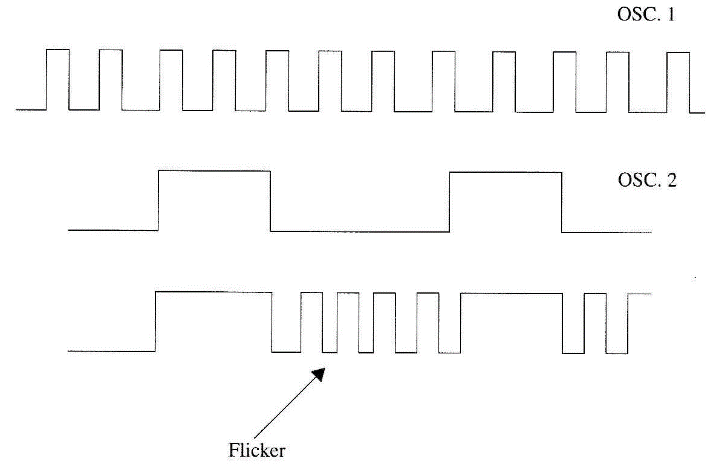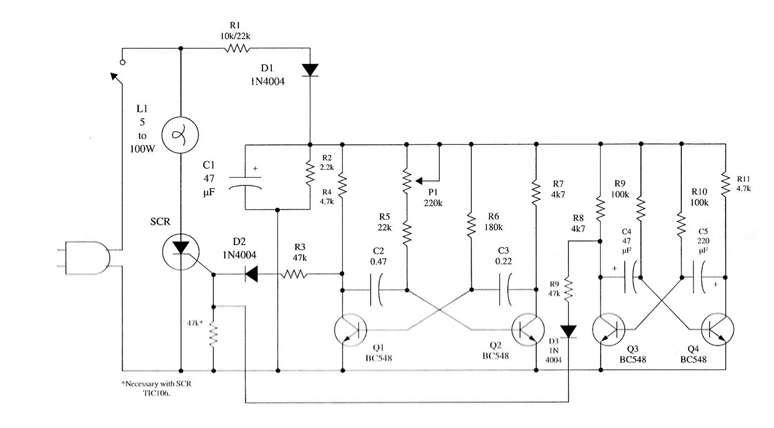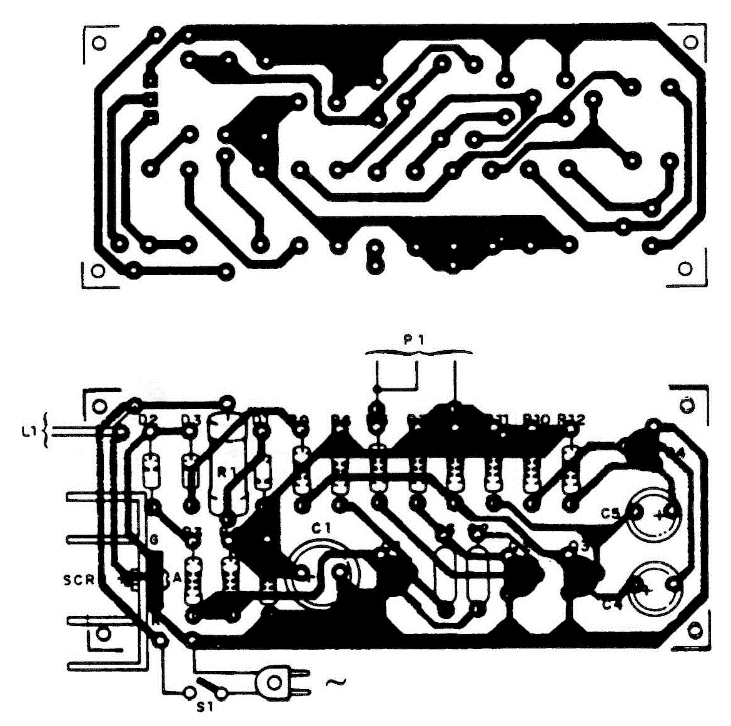The circuit described here imitates the flickering of a flame by controlling the brightness of a common incandescent lamp. Incandescent lamps with power in the range between 5 and 100 W or higher can be used in experiments, which is equivalent to the light produced by many candles. Mays experiments can be suggested for using this circuit, as described below.
Experiments
■ The flickering flame effect reproduced by a lamp can be useful to help a subject enter the trance state in an ESP experiment. It also can be used as a hypnotic aid in experiments involving transcendental meditation and biofeedback.
■ The subject can try to change the light effect produced by this device using his mental powers. The effect can also be used to help the subject concentrate his mind on an object to be moved.
■ Filling an ambient with the light produced by this device, the subject can achieve the fourth consciousness state or trance state more easily.
■ In radiesthesia, the effects of an illumination that imitates a candle can be used in experiments involving the action of a pendulum and its effect on subjects.
■ The mystic aspect of a candle illumination can be useful in experiments involving ghosts, spirits, and other paranormal manifestation. The location where the phenomenon will occur can be illuminated by this device.
How it Works
Two astable multivibrators using common transistors operate as modulators running in different frequencies. The first multivibrator has its frequency determined by C2 and C3 and the second by C4 and C5. The multivibrators use different values for these capacitors, as they have to produce square signals with duty cycles other than 50%. This means that short pulses applied to the lamp result in the flickering effect. The use of two oscillators also makes the lamp flicker at a random rate, as does a real candle.
The signals produced by the two multivibrators are combined by diodes D2 and D3 and applied to the gate of an SCR. This means that the SCR receives a random train of pulses, as shown in Fig. 1, producing the flickering effect.
The low voltage necessary to power the multivibrators comes from Dl and is filtered by C2. R1 has a value that depends on the ac power line. For a 117 Vac power line, a 10 Id) resistor is indicated. A 22 kΩ resistor is recommended for a 220/240 Vac power line.
Note that all parts of the circuit, including the low-voltage stages, are connected to the ac power line. This means that the circuit must be assembled to avoid the possibility of anyone touching active parts to avoid shock.
Assembly
Figure 2 shows the complete schematic diagram of the electronic candle. The components are placed on a printed circuit board as shown in Fig. 3.
The SCR must be mounted on a small heatsink. The suffix depends on the ac power line voltage. If the circuit will be powered from a 117 Vac power line, types with B or D suffixes are suitable. For a 220/240 Vac power line, use the types with suffix D.
Any incandescent lamp rated in the range between 5 and 100 W can be used. Types that look like a candle are recommended if the reader can find them.
The transistors are not critical, and the electrolytic capacitors should have volt-age ratings to 16 V or more.
As the circuit is powered from the ac power line and no isolation transformer is used, special care must be taken to avoid shock. Isolate the circuit inside a plastic or wooden box.
The lamp can be mounted on the upper side of the box or, if you prefer, placed at a distance from the device and connected by a long wire.
Testing and Using the Circuit
Plug the device into any ac power line and turn on S1. Adjust P1 to have a flickering effect in the lamp to suit your expectations. If you don't like the effects (e.g., if, due to component tolerances, they do not suitably imitate a candle), you may want to make some alterations in the circuit. See in the item in the "Suggestions" section for instructions on how to do that.
If the circuit doesn't function, check the voltage at C1. The voltage must be 8 V. If necessary, alter the value of R2 to achieve this voltage.
Suggestions
■ To change the flickering effect, you can make the following component changes:
C2 in the range between 0.22 and 1 µF
C3 in the range between 0.047 and 0.47 µF
C4 in the range between 10 and 220 µF
C5 in the range between 47 and 470 µF
These alterations can compensate for tolerance problems in the capacitors.
■ Use an IR or UV incandescent lamp for the experiments.
■ Replace R11 with an LDR and control the effect by the ambient light. The LDR must not be illuminated by the device's circuit lamp, or you will get feedback.
■ You can also replace R6 with an LDR to control the effect in another point of the circuit.
Semiconductors
SCR MCR106 (4 or 6) or TIC106-B or D (according the AC power line) silicon-controlled rectifier (see text)
Q1, Q2, Q3, Q4 BC548 or equivalent - general purpose NPN silicon transistors
D1, D2, D3 1N4004 or 1N4007 - silicon rectifier diodes
Resistors
R1 10 kΩ (117 Vac) or 22 kΩ (220/240 Vac) x 10 W. wire-wound (see text)
R2 2.2 kΩ, 1/8 W, 5%—red, red, red
R3, R9 47 kΩ, 1/8W, 5%—yellow, violet, orange
R4, R7, R8, R12 4.7 kΩ, 1/8W, 5%—yellow, violet, red
R5 22 kΩ, 1/8W, 5%—red, red, orange
R6 180 kΩ, 1/8 W, 5%—brown, gray, yellow
R10, R11 100 kΩ, 1/8 W, 5%—brown, black, yellow
Capacitors
C1, C4 47 µF/16 WVDC, electrolytic
C2 0.47 µF, ceramic or metal film
C3 0.22 µF, ceramic or metal film
C5 220 µF/16 WVDC, electrolytic
Miscellaneous
P1 47,000 to 220 kΩ potentiometer
S1 SPST, toggle or slide switch
X1 Incandescent lamp, 5 to 100 W f see text)
Printed circuit board, plastic or wooden box, power cord, heatsink for the SCR, knob for the potentiometer, wires, solder, etc.






